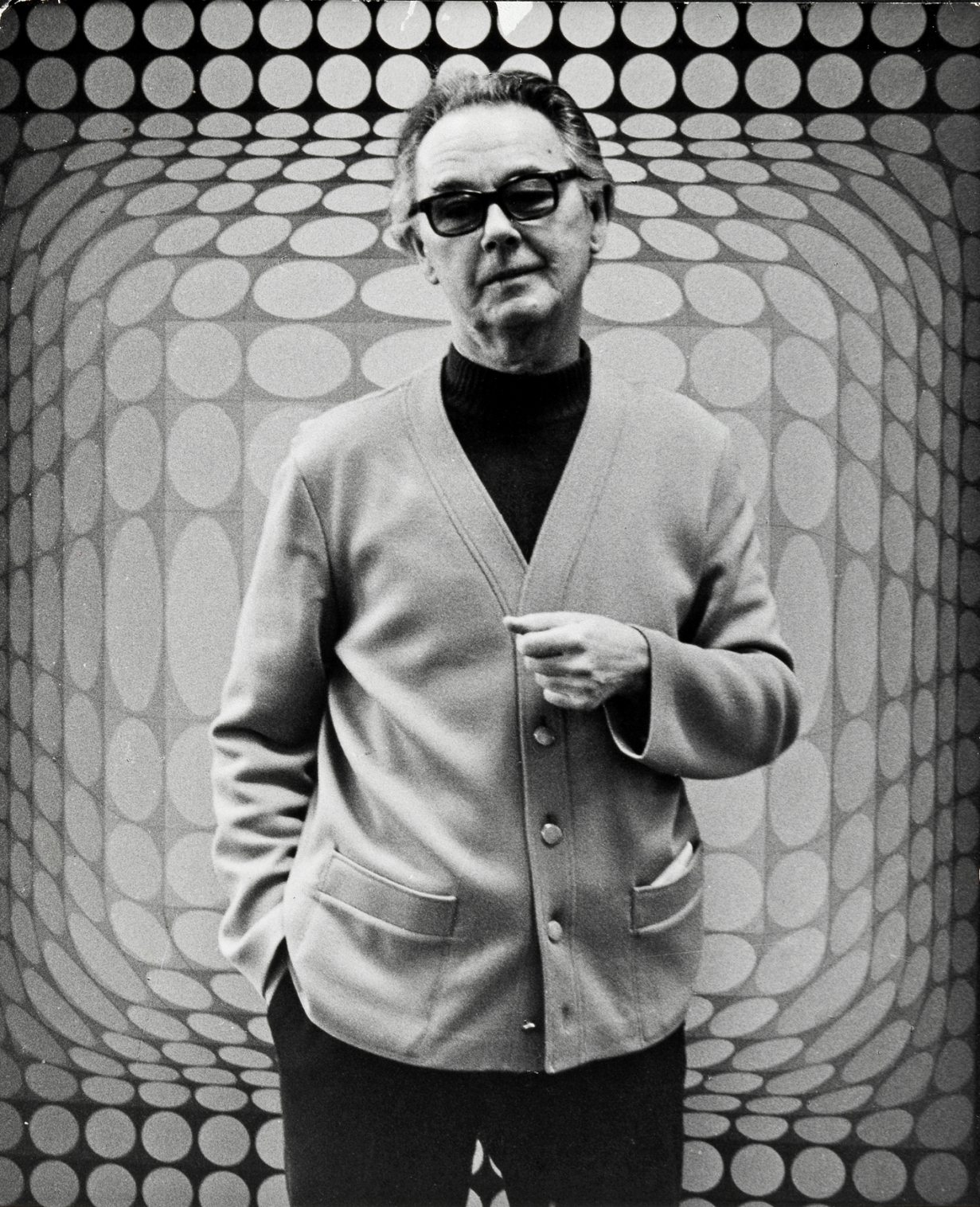More about Victor Vasarely
- All
- Info
- Shop
Works by Victor Vasarely

Contributor
Victor Vasarely defined the aesthetic of an entire movement, yet today his name remains in obscurity outside of the art historical bubble.
Though his name may not ring a bell, his work gives the unassuming viewer the eerie sense that they’ve seen it somewhere before. That’s because they probably have seen it somewhere else.
His signature black-and-white patterns warped by an unseen force tend to make the viewer question what the hell they’re actually looking at. Vasarely aimed to create kinetic art, in the same category as Alexander Calder’s ethereal mobiles, without making the artwork physically move. After looking at any single painting of Vasarely’s, the viewer’s head spins into its dizzying pattern, lost among the checkerboard pieces twisted by some strange distortion of the space-time continuum.
Best known for his work in Op-Art (art that creates an optical illusion), Vasarely’s work stands as a testament to the psychedelic era of the 1960s. By this point, Vasarely’s fame had increased considerably due to his influence on pop culture. The patterns and motifs featured in his artwork became increasingly relevant to the “drop-in, drop-out” culture of the ‘60s. The ‘trippy’ effects of his Op-Art increasingly became a signature aesthetic of the time. These patterns and this type of imagery became increasingly prevalent as more and more counterculturalists began to experiment with psychedelic drugs such as LSD and psilocybin mushrooms.
You may also recognize his patterns because the infamous clothing designer Giovanni Versace avidly collected Vasarely’s artwork and created textiles that were heavily inspired by Vasarely’s work. The signature Versace aesthetic of distorted black and white stripes contrasted with golden swirls nods to Vasarely’s body of work, particularly his painting entitled Zebra. Often considered the first example of Op-Art, Zebra features a pair of zebras so stretched and contorted that two zebras become one dizzying mass, inseparable from one another.
Vasarely’s creation of his own artistic language, the Alphabet Plastique, serves as a major hallmark of his career. The name makes me think of those plastic letter magnets that children can rearrange on their fridge to spell out words, but Vasarely’s plastic alphabet is more than a simple children’s toy. Essentially, Vasarely developed this technique of art creation that likens form to what might be most closely associated with the computer programming language of binary. In this system, every letter of the alphabet corresponds to a color, shape, and sound. Vasarely believed that through this simplified artistic language, he could make the world a better place. He believed that the Alphabet Plastique had the power to create a world in which art knew no geographic borders, no language barriers. It would be a universal language both for art and architecture. This method would strip art of cultural and national boundaries and any reference to the natural, organic world. The visual effects of these paintings would mean exactly the same thing to anybody who looked at it, regardless of their contextual understanding of it.
If you take away one thing from reading this article, please let it be the fact that Victor Vasarely designed the cover of David Bowie’s Space Oddity. Not because that’s the most significant achievement of his career, but because it’s a very fun fact that you can share with your die-hard Bowie fan friends to impress them with your vast knowledge of 1960s psych-rock.
Sources
- Grovier, Kelly. “Victor Vasarely: The Art That Tricks the Eyes.” BBC. BBC, March 5, 2019. http://www.bbc.com/culture/story/20190305-victor-vasarely-the-art-that-….
- “The Influence of Victor Vasarely.” Art for Sale: Vertu Fine Art, n.d. https://vertufineart.com/the-influence-of-victor-vasarely/.
- Santoro, Gary. “Vasarely: Victor Vasarely Paintings: Victor Vasarely Biography.” Art for Sale: Vertu Fine Art, May 7, 2019. https://vertufineart.com/artists/victor-vasarely/#content.
- “Victor Vasarely.” artnet. ArtNet Worldwide Corporation, n.d. http://www.artnet.com/artists/victor-vasarely/.
- “Victor Vasarely Art, Bio, Ideas.” The Art Story, 2019. https://www.theartstory.org/artist/vasarely-victor/.
Featured Content
Here is what Wikipedia says about Victor Vasarely
Victor Vasarely (
French: [viktɔʁ vazaʁeli]; born Győző Vásárhelyi,
Hungarian: [ˈvaːʃaːrhɛji ˈɟøːzøː]; 9 April 1906 – 15 March 1997) was a Hungarian-French artist, who is widely accepted as a "grandfather" and leader of the Op art movement.
His work titled Zebra, created in 1937, is considered by some to be one of the earliest examples of Op art.
Check out the full Wikipedia article about Victor Vasarely












